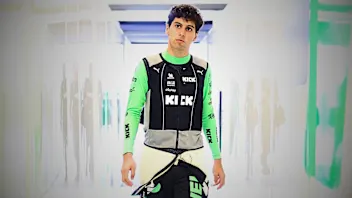Bahrain, according to Mercedes-Benz head of motorsport Toto Wolff, showcased Nico Rosberg "at his best - a fantastic, aggressive driver". It wasn't just the beautifully judged overtakes that hammered home the point - in the Race Performance Ratings, the German was also resurgent. In the third of five features explaining how the Ratings are calculated, we take a look at Aggression, and ask what it can tell us about how Rosberg and others performed across F1 racing's first double-header of the 2015 campaign...
What are Race Performance Ratings?
Available exclusively to F1® Access subscribers, Formula1.com's live Race Performance Ratings track every input a driver makes in real-time - offering fans unprecedented insight into how the Grand Prix is unfolding.
Five key parameters are measured: Aggression, Braking, Cornering, Steering and Throttle. Each category is determined by the raw telemetry from each driver, but given the sensitive nature of that data the Ratings are expressed as an indexed score, with each driver ranked on a scale of 1-10 based on how they compare to their competitors.
The individual scores for each of the five categories - which update every five seconds throughout the race - are averaged to give an overall Race Performance Rating, which can be tracked live during each race in 2015.
Aggression
The Aggression score is a reflection of the longitudinal g-force each driver generates, both through acceleration and retardation. The g-forces acting in either direction are recoded and averaged, with each driver then indexed against the overall average for the entire field. A high score indicates a hard-charging style, with a low score reflecting that less g-forces are being achieved.
China and Bahrain head-to-head
China and Bahrain taking place back-to-back provides the ideal opportunity to compare and contrast drivers' ratings across the two Grands Prix. Such comparisons allow us to identify trends across races and between team mates– something that will be fascinating to monitor as the season progresses. So what can Shanghai and Sakhir tell us about Aggression?
Rosberg resurgent in Bahrain, after Hamilton bottles him up in China
In three of the first four races, there has been almost nothing to choose between Mercedes team mates Lewis Hamilton and Nico Rosberg in their Aggression scores. China, however, was different.

The graph above shows Rosberg and Hamilton's Aggression Ratings in both Shanghai and Sakhir. Two trends are immediately apparent: 1, that both scored far higher in the latter race; and 2, that while the pair are very evenly matched in Bahrain, their scores in China are massively different.
The first trait is perhaps best explained by the fact that Bahrain was less complicated in terms of tyre management for the Silver Arrows. Where their strategy in China involved a step into the unknown in terms of stretching out tyre life, Mercedes had a better handle on degradation on what was a more comfortable two-stop strategy in Bahrain. Where caution was necessary in China, in Sakhir they appeared able to push harder into and out of the corners.
That pattern is then reflected in the second trend. With Hamilton exercising a degree of pragmatic caution in Shanghai, Rosberg became bottled up behind his team mate, much to his later chagrin. His braking and corner exit slightly compromised - an inevitable part of shadowing another car - his score is significantly lower than Hamilton's. In Bahrain, by contrast, Rosberg was able to scythe his way past the Ferraris on several occasions. That not only earned him Wolff's praise , it also ensured that his pace - and his Aggression score - was not compromised.
It is worth noting that Hamilton's score in China spikes at lap 34. This was the critical part of the race for the Briton: he had stayed out two laps longer than Rosberg and Sebastian Vettel, and was therefore at risk of the undercut, or of being overtaken while his new medium tyres were not up to temperature. His high score suggests Hamilton pushed very hard on that out-lap to ensure he preserved his lead - once there, his score returns to its previous level, suggesting he was able to ease back once more. The fact no other driver has such a spike appears to be a testament to just how masterfully Hamilton controlled the race.
A final note: both Hamilton and Rosberg's Aggression scores - and to an even larger extent their Braking scores (not surfaced here) - drop away over the final two laps, reflecting their late issues with the Mercedes brake-by-wire system.
Perez, Hulkenberg and the secret of two stops in Sakhir
Sergio Perez has gained a well-deserved reputation for excellent tyre management during his time in F1 racing, and he demonstrated his finesse with aplomb in Bahrain.

The graph above maps Perez against his Force India team mate Nico Hulkenberg (and the rest of the field, greyed out) in Bahrain. Perez actually scores lower than Hulkenberg throughout - but that is only half the story.
As ever with the Ratings, a high score in any one category does not translate directly to lap time. In fact, a driver's overall pace is an incredibly complex fusion of myriad factors, including their own driving style and how that fuses with the traits of their car. Considering the Ratings alongside lap times, though, can offer a fascinating insight - and the Force India duo are a perfect example.
While Perez's lower aggression score indicates that he is pulling lower longitudinal g-forces than Hulkenberg on both corner entry and exit, he is actually faster than Hulkenberg, particularly in the middle stages of the race. It's not the only advantage Perez has: being less aggressive on corner entry and exit inevitably places less demand on the tyres. Hulkenberg, meanwhile, takes more life from his tyres, which affects his pace later in each stint - a vicious circle. Eventually he has to stop three times and can only finish 13th, from eighth on the grid. Perez, in contrast, masters a different driving approach and is able to execute a two-stop strategy that enables him to pick up two championship points in eighth - proof that, in the Ratings and F1 racing in general, less is sometimes more…
Lotus top of the pile, while Ricciardo makes gains
While several teams and drivers - including Rosberg, as noted above - had markedly different scores between China and Bahrain, one team was consistent across both races: Lotus.

Given that both Romain Grosjean and Pastor Maldonado were top of the Aggression charts for China and Bahrain - and in fact for Malaysia too - the duo's high score is perhaps down more to the traits of the Lotus E23 Hybrid, and how the team choose to set it up, than individual quirks of driving style.
It is worth noting, for example, that Lotus ranked very highly - if not top - in the speed trap at the two most recent Grands Prix. Braking from higher speeds on the straights will obviously contribute to higher g-forces under braking, and therefore a higher aggression score. As stated above, this appears to be a consistent trend, indicating that Lotus have started 2015 with a very specific set-up philosophy. It will be interesting to monitor whether that persists in races like Monaco, where top speed is less of a priority.
On the flip side, Red Bull's Daniel Ricciardo had one of the lowest aggression ratings in China, with only a handful of cars, including the two Marussias, scoring lower.
Like Rosberg in the same race, this appears to reflect the detriment of being held up by other cars. In this example, Ricciardo's poor start dropped him down the field immediately, and consigned him to fighting his way back up the order for the rest of the race.
The Australian's trace visibly improves from around lap 37, the moment he makes his final stop for medium tyres and emerges with slightly clearer air in 11th. No longer bottled up - he quickly closes down and then passes Sauber's Marcus Ericsson - his score relative to the rest of the field improves all the way to the flag, where his classified a comfortable ninth.
Enhance the way you experience Formula 1 racing, and discover a level of detail you won't find anywhere else - complete with in-depth insights, exclusive content, up-to-the-minute race data, and more - with F1® Access. To find out more, click here.
Next Up
Related Articles
 Quiz20 quiz questions on the 2025 Formula 1 season
Quiz20 quiz questions on the 2025 Formula 1 season Antonelli picks standout moments from rookie season
Antonelli picks standout moments from rookie season/TEAM%20PREVIEWSHALF%20TERM%20REPORTS%20DISPLAY%20V1%20(13).webp) End Of Year Reports 2025Racing Bulls’ best and worst moments from 2025
End Of Year Reports 2025Racing Bulls’ best and worst moments from 2025 End Of Year Reports 2025Haas’ best and worst moments from 2025
End Of Year Reports 2025Haas’ best and worst moments from 2025 ExclusiveBortoleto on his rookie year and Audi excitement
ExclusiveBortoleto on his rookie year and Audi excitement End Of Year Reports 2025McLaren’s best and worst moments from 2025
End Of Year Reports 2025McLaren’s best and worst moments from 2025